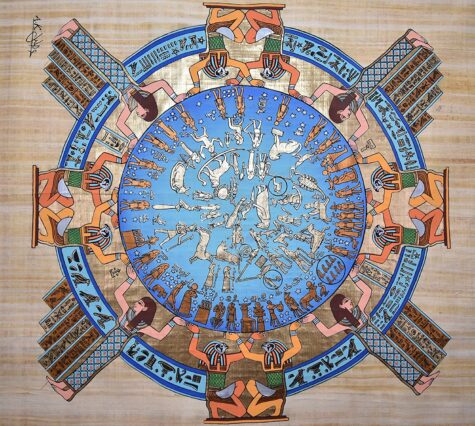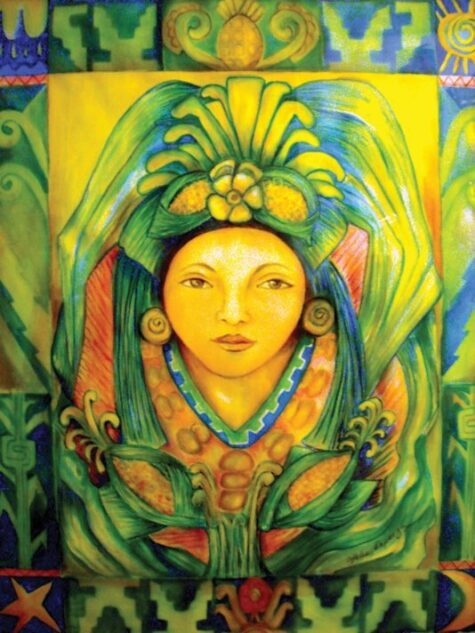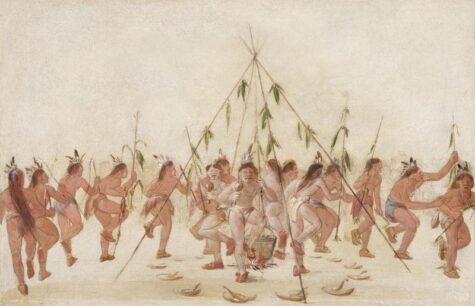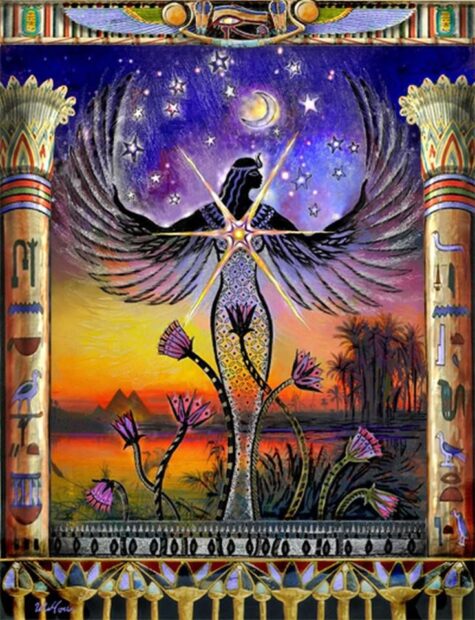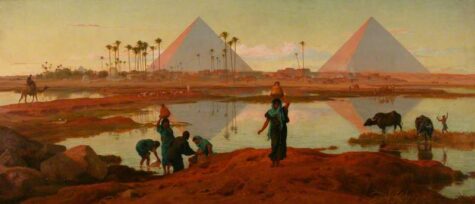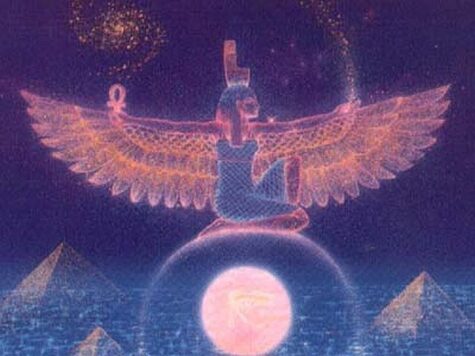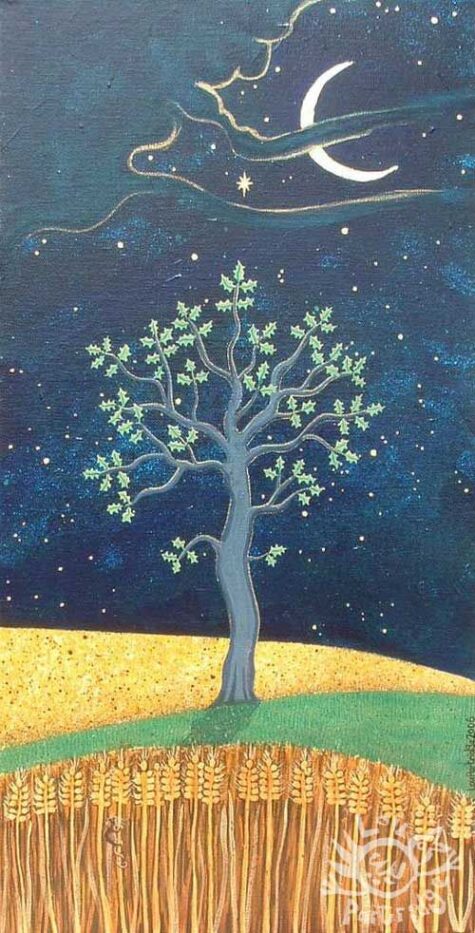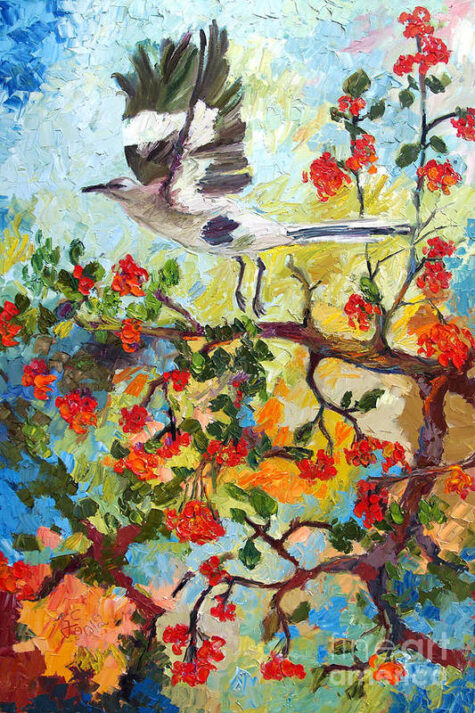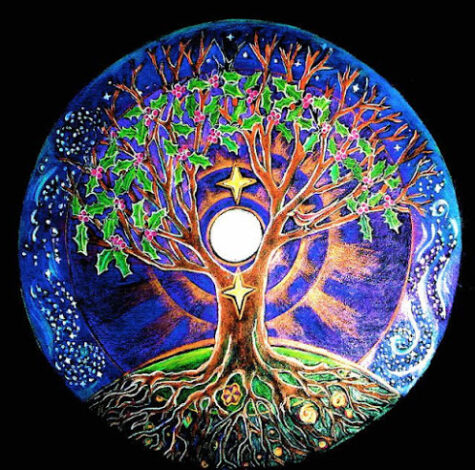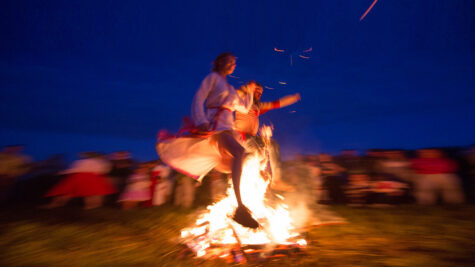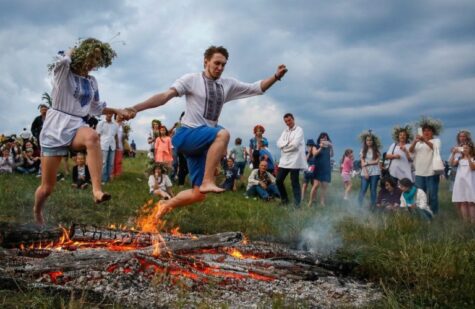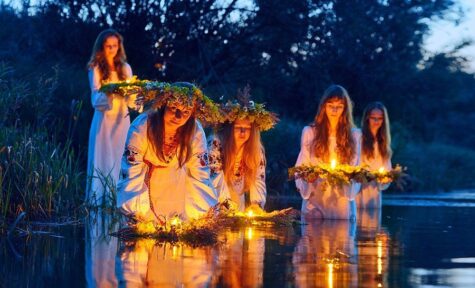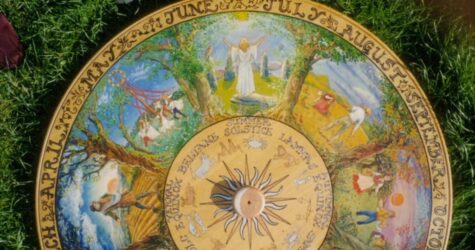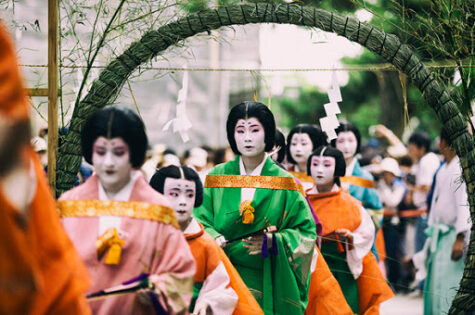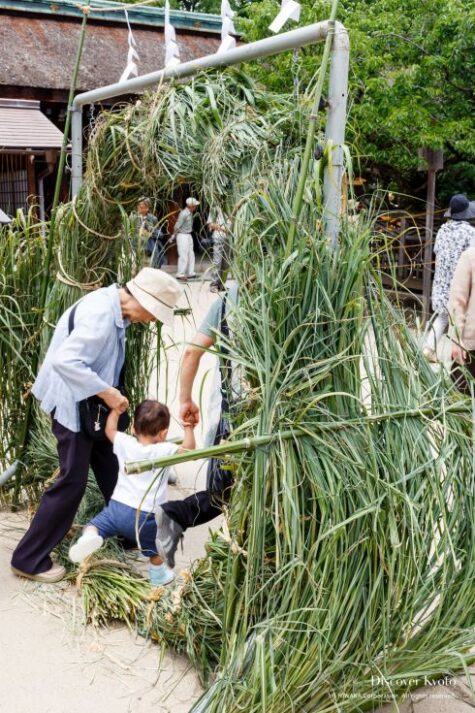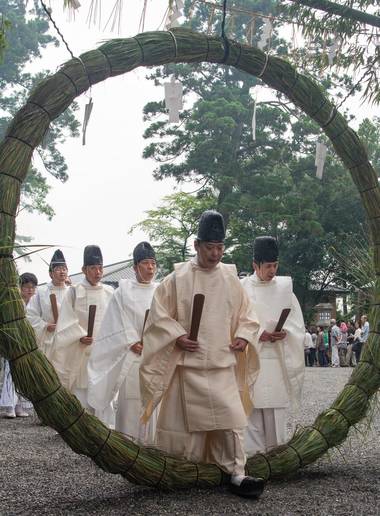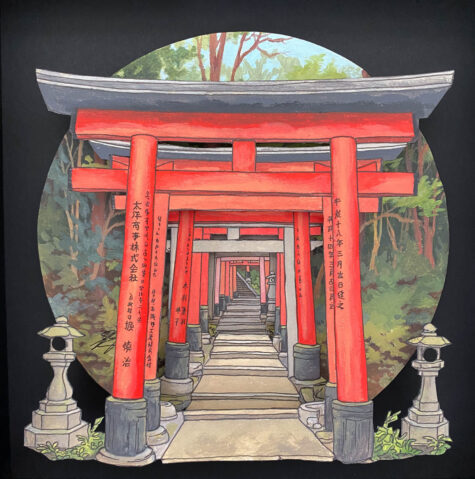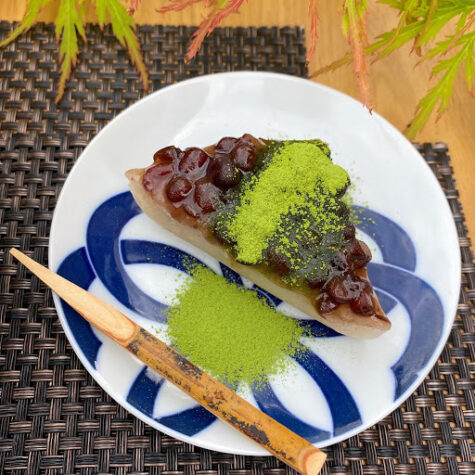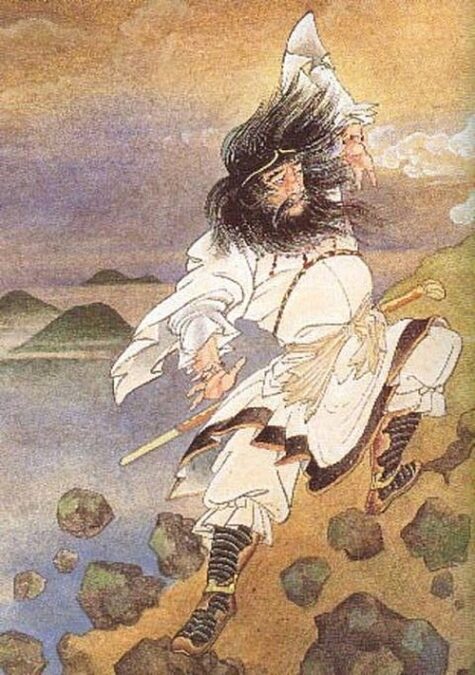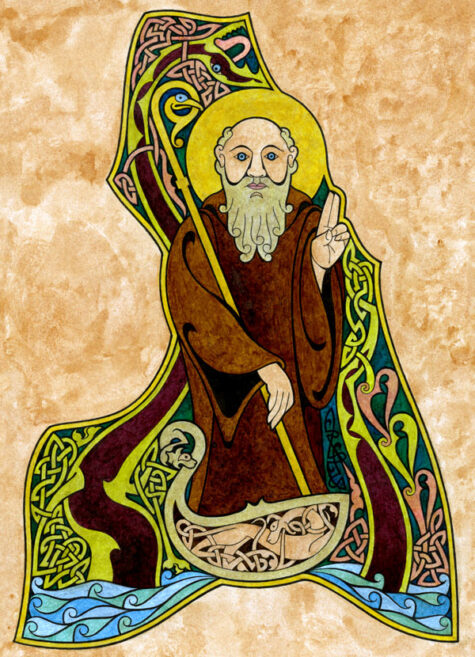Yearly Archives: 2021
The 5 Epagomenal Days (6 during leap years) were inserted into the Egyptian Calendar which had been 360 days long. These days were reserved as birthdays for the gods. The first, third, and fifth of these days were considered unlucky by the Egyptians.
The legend behind the days holds the Nut had been forbidden to have children on any day of the year by her husband Geb. Thoth, upon hearing this, gambled with the moon-god for a fraction of his light. Thoth won and he created the additional 5 days for Nut so she could bear children on these days “not of the year.”
They are as follows:
- July 27 – 1st Epagomenal Day – Birthday of Osiris
- July 28 – 2nd Epagomenal Day – Birthday of Horus
- July 29 – 3rd Epagomenal Day – Birthday of Set
- July 30 – 4th Epagomenal Day – Birthday of Isis
- July 31 – 5th Epagomenal Day – Birthday of Nephthys
Note:
These dates come from Traci de Regulla in The Mysteries of Isis. She took her dating from Dr. Robert Brier’s Ancient Egyptian Magic. There is a great deal of dispute when it comes to calculating the dates of Egyptian festivals due to problems in their calendar system (it was only 360 days for some period of time).
The Green Corn Ceremony typically occurs in late July– early August, determined locally by the ripening of the corn crops. The ceremony is marked with dancing, feasting, fasting and religious observations.
The Green Corn Ceremony is a celebration of many types, representing new beginnings. Also referred to as the Great Peace Ceremony, it is a celebration of thanksgiving to Hsaketumese (The Breath Maker) for the first fruits of the harvest, and a New Year festival as well.
The Feast of Green Corn and Dance gives honor to Mantoo (Creator) provider of all things and celebrates our harvest, ancestors, elders, veterans, family and Native American heritage.
The Green Corn Ceremony is an annual ceremony practiced among various Native American peoples associated with the beginning of the yearly corn harvest.
These ceremonies have been documented ethnographically throughout the North American Eastern Woodlands and Southeastern tribes. Historically, it involved a first fruits rite in which the community would sacrifice the first of the green corn to ensure the rest of the crop would be successful.
These Green Corn festivals were practiced widely throughout southern North America by many tribes evidenced in the Mississippian people and throughout the Mississippian Ideological Interaction Sphere. Green Corn festivals are still held today by many different Southeastern Woodland tribes.
Literally the spirit of the corn in Native American traditions, Corn Mother brings with her the bounty of earth, its healing capabilities, it’s nurturing nature, and its providence.
- Symbols: Corn; Corn Sheaves
- Themes: Abundance; Children; Energy; Fertility; Harvest; Health; Grounding; Providence; Strength
This is the season when Corn Mother really shines, beautiful with the harvest. She is happy to share of this bounty and give all those who seek her an appreciation of self, a healthy dose of practicality, and a measure of good common sense.
To Do Today:
Around this time of year the Seminole Indians (in the Florida area) dance the green corn dance to welcome the crop and ensure ongoing fertility in the fields and tribe. This also marks the beginning of the Seminole year. So, if you enjoy dancing, grab a partner and dance? Or, perhaps do some dance aerobics. As you do, breathe deeply and release your stress into Corn Mother’s keeping. she will turn it into something positive, just as the land takes waste and makes it into beauty.
Using corn in rituals and spells is perfectly fitting for this occasion. Scatter cornmeal around the sacred space to mark your magic circle, or scatter it to the wind so Corn Mother can bring fertility back to you. Keeping a dried ear of corn in the house invokes Corn Mother’s protection and luck, consuming corn internalizes her blessings.
The traditional Ceremony:
The Busk or Green Corn Ceremony is the celebration of the New Year, so at this time all offenses are forgiven except for rape and murder, which are executable or banishable offenses.
In modern tribal towns and Stomp Dance societies only the ceremonial fire, the cook fires and certain other ceremonial objects will be replaced. Everyone usually begins gathering by the weekend prior to the ceremony, working, praying, dancing and fasting off and on until the big day.
The whole festival tends to last seven-eight days, if you include the historical preparation involved (without the preparation, it lasts about four days).
- Day One
The first day of the ceremony, people set up their campsites on one of the square ceremonial grounds. Following this, there is a feast of the remains of last year’s crop, after which all the men of the community begin fasting (historically, the women were considered too weak to participate). That night there is a social stomp dance, unique to the Muscogee and Southeastern cultures.
- Day Two
Before dawn on the second day, four brush-covered arbors are set up on the edges of the ceremonial grounds, one in each of the sacred directions.
For the first dance of the day, the women of the community participate in a Ribbon or Ladies Dance, which involves fastening rattles and shells to their legs perform a purifying dance with special ribbon-clad sticks to prepare the ceremonial ground for the renewal ceremony.
The ceremonial fire is set in the middle of four logs laid crosswise, so as to point to the four directions. The Mico (head priest) takes out a little of each of the new crops (not just corn, but beans, squash, wild plants, and others) rubbed with bear oil, and it is offered together with some meat as “first-fruits” and an atonement for all sins.
The fire (which has been re-lit and nurtured with a special medicine by the Mico) will be kept alive until the following year’s Green Corn Ceremony. In traditional times, the women would sweep out their cook-fires and the rest of their homes and collect the filth from this, as well as any old clothing and furniture to be burnt and replaced with new items for the new year.
The women then bring the coals of the fire into their homes, to rekindle their home fires. They can then bake the new fruits of the year over this fire (also to be eaten with bear oil). Many Creeks also practice the sapi or ceremonial scratches, a type of bloodletting in the mid morning, and in many tribes the men and women might rub corn milk, ash, white clay, or analogous mixtures over themselves and bathe as a form of purification.
They also drink a medicine referred to as the “White Drink.” (English traders referred to it as the “Black Drink” due to its dark liquid which froths white when shaken before drinking).
This White Drink, known to strangers as Carolina Tea, is a caffeine-laden mixture of seven to fourteen different herbs, the main ingredient being assi-luputski, Creek for “small leaves” of Yaupon Holly.
This medicine was intended to help receive purification, as it is a purgative when consumed in mass amounts. (Historically, only men drank enough of the liquid to throw up.) The purgative was consumed to clean the dietary tract of last year’s crop and to truly renew oneself for the new year.
- Day Three
While the second day tends to focus on the women’s dance, the third is focused on the men’s. After the purification of the second day, men of the community perform the Feather Dance to heal the community.
The fasting usually ends by supper-time after the word is given by the women that the food is prepared, at which time the men march in single-file formation down to a body of water, typically a flowing creek or river for a ceremonial dip in the water and private men’s meeting. They then return to the ceremonial square and perform a single Stomp Dance before retiring to their home camps for a feast.
During this time, the participants in the medicine rites are not allowed to sleep, as part of their fast. At midnight a Stomp Dance ceremony is held, which includes feasting and continues on through the night. This ceremony usually ends shortly after dawn.
- Day Four
The fourth day has friendship dances at dawn, games, and people later pack up and return home with their feelings of purification and forgiveness. Fasting from alcohol, sexual activity, and open water will continue for another four days.
More Information
Puskita, commonly referred to as the “Green Corn Ceremony” or “Busk,” is the central and most festive holiday of the traditional Muscogee people. It represents not only the renewal of the annual cycle, but of the spirit and traditions of the Muscogee. This is representative of the return of summer, the ripening of the new corn, and the common Native American traditions of environmental and agricultural renewal.
Historically in the Seminole tribe, 12-year-old boys are declared men at the Green Corn Ceremony, and given new names by the chief as a mark of their maturity.
Several tribes still participate in these ceremonies each year, but tribes who have historic tradition within the ceremony include the Iroquois, Cherokee, Creek, Choctaw, and Seminole tribes. Each of these tribes may have their own variations of celebration, dances and traditions, but each performs a new-year’s ceremony involving fasting and several other comparisons each year.
Sources:
July 19 was a very important date in ancient Egyptian Cosmology. Known as ‘The Opening of the Year,” or the “Sothic New Year,” it was celebrated with a festival known as “The Coming of Sopdet.”
The oldest festival in ancient Egyptian history, the celebration of The Opening of the New Year began with the rising of Sirius who appeared as the goddess Isis cloaked in robes of brilliant light.
The sky is serene. Sothis lives. She shines, a peaceful flame.
Unas lives eternal as the son of Sothis,
As the child of Isis, as a child of Light,
As Earth is child of the Cosmos.
Unas is pure. She is pure,
As are all the gods whoever lived since the beginning of time
In the worlds above and in the worlds below.
They have been born the Imperishable Stars
Living within the Meshetiu, which shall never die.
~Pyramid Text Utterance 302
Sirius forms a part of the constellation Canis Major, sometimes referred to as the Dog Star. Of all the stars in the sky throughout the year, Sirius shines the brightest. The Greeks called the star Sothis, meaning “The Soul of Isis”. The Egyptians called her Sept or Sopdet, referring to the concept of preparing for the future. The ancient feast day name Per Sopdet may be translated as T”he Coming Forth of the Goddess.”
On this day Sirius, the “Dog Star”, rose together with Sun and announced the annual flooding of Nile River. The lands were watered and a black layer of slime covered them, providing humidity and fertilizer for next year’s harvest: the nation would not suffer of hunger. Thus it was the first year of the mystical Egyptian year, symbolizing transmutation and fertility.
Note: The actual date of this event in ancient Egypt is different than the current date because the date slowly varies within the Gregorian calendar, owing to its omission of three leap years every four centuries. It presently occurs on 3 August.
Ancient Egyptian Rites and Festivities
When Sirius reappeared as the morning star, the altars at the Isis temples of Philae, Karnak, and Dendera opened early. The portals and sanctuaries were aligned so precisely with the heavenly bodies that the predawn starlight of Sirius was projected onto the cult statue of the goddess. Thus began a season of preparation for the coming agricultural year and a celebration of the flood and fecundity of earth.
New Year’s Day in every temple across the land began with the lighting of the wicks for the temple fires. The glowing lamplight symbolized the eternal life of the spirit world and the flame’s earthly burning became a mirrored image of the glittering light of Sothis in the sky.
The lifting of the fires was usually followed by an offering of bread and prayers glorifying the dead, enacted in the northern corner of the temple – the northern region being linked with the souls of the ancestors, the Imperishable Ones who were the circumpolar stars.
When the Opening of the year or Wept Renpet was celebrated, it was also a day to celebrate the traditional birthday of the king and later the Pharoah – no matter the true date of his birth. The New Year’s Feast was an important festival in the life of the Egyptian ruler. It involved his ritually hoeing the ground and breaking the dirt clods in preparation for the sowing that would follow the receding waters.
The water stands and fails not, and the Nile carries a high flood. The days are long, the nights have hours, and the months come aright. The Gods are content and happy of heart, and life is spent in laughter and wonder.
~Prayer from the Sallier Papyrus
The galleries inside the pyramids point to the heavenly position of Sirius on such a day. Sirius was both the most important star of ancient Egyptian astronomy, and one of the Decans. Decans are star groups into which the night sky was divided, with each group appearing for ten days annually. The first night that Sirius is seen, just before dawn (heliacal rising) was noticed every year during July, and the Egyptians used this to mark the start of the New Year.
In fact, the “Sothic Rising” only coincided with the solar year once every 1460 years. The Roman emperor Antoninus Pius had a commemorative coin made to mark their coincidence in AD 139. The Sothic Cycle (the periods between the rising of the star) have been used by archaeologists trying to construct a chronology of Ancient Egypt.
About Sopdet
Sirius was named Sothis by Egyptians and from archaic ages it symbolized eternity and fertility. As early as the 1st Dynasty, she was known as ‘the bringer of the new year and the Nile flood. Sopdet took on the aspects of a goddess of not only the star and of the inundation, but of the fertility that came to the land of Egypt with the flood. The flood and the rising of Sirius also marked the ancient Egyptian New Year, and so she also was thought of as a goddess of the New Year.
- Themes: Fertility, Destiny, Time
- Symbols: Stars and Dogs.
Not just a goddess of the waters of the inundation, Sopdet had another link with water – she was believed to cleanse the pharaoh in the afterlife. It is interesting to note that the embalming of the dead took seventy days – the same amount of time that Sirius was not seen in the sky, before it’s yearly rising. She was a goddess of fertility to both the living and the dead.
In the Pyramid Texts, she is the goddess who prepares yearly sustenance for the pharaoh, ‘in this her name of “Year”‘. She is also thought to be a guide in the afterlife for the pharaoh, letting him fly into the sky to join the gods, showing him ‘goodly roads’ in the Field of Reeds and helping him become one of the imperishable stars. She was thought to be living on the horizon, encircled by the Duat.
The reigning Egyptian Queen of the Constellations, Sopdet lives in Sirius, guiding the heavens and thereby human destiny. Sopdet is the foundation around which the Egyptian calendar system revolved, Her star’s appearance heralding the beginning of the fertile season. Some scholars believe that the Star card of the Tarot is fashioned after this Goddess and Her attributes.
The long, hot days of summer are known as the ‘Dog Days‘ because they coincide with the rising of the dog star, Sirius. In ancient Egypt this was a welcome time as the Nile rose, bringing enriching water to the land.
Activities for Today
Go outside tonight and see if you can find Sirius. When you spy it, whisper a wish to Sopdet suited to Her attributes and your needs. For example, if you need to be more timely or meet a deadline, she’s the perfect Goddess to keep things on track.
If you’re curious about your destiny, watch that region of the sky and see if any shooting stars appear. If so, this is a message from Sopdet. A star moving on your right side is a positive omen; better days are ahead. Those on the left indicate the need for caution, and those straight ahead mean things will continue on an even keel for now. Nonetheless, seeing any shooting star means Sopdet has received your wish.”
- Recall a new beginning
Recall a time in your life when you were starting anew, perhaps after a divorce or when moving into a new home. Perhaps your new life followed the birth of a child or a change in career. Investigate what had to die in your old life in order for the new life to emerge. How did that feel as you stood poised on the brink of change?
- Explore your creativity
Explore what it means to be creative. Think about the most creative times in your life. Where did you live? How different did life seem then from the way it seems now? How was your time structured? What were you thinking, desiring, telling yourself on a daily basis? Can you duplicate any of that in your life now?
- Ten Things
Make a list right now of ten things you want to manifest in the next six months. Be specific. Plant three seeds for each thing you want to manifest, then tend to them. Mark each seed with a popsicle stick to indicate what goal you are germinating, so that when you water the plant, you stay focused on what you are nurturing within yourself.
Write a brief prayer to one of the abundance goddesses – Isis, Hathor, or Anket – asking her to guide you and oversee your fecundity. Say your prayer each time you tend your plants.
Sources:
- Tour Egypt
- Journeying To The Goddess
- Feasts of Light
The eighth Celtic Moon month sees in the start of the waning of the days. The power of the Sun is transferred to the Earth, highlighting our practical needs and desires. The Celtic fire festival of Lammas begins the harvest on 1st August. Thus, the month of the Holly Moon is a time to give thanks for what you have and to appreciate the good things in your life. Focus on your own ‘harvest’ during the month of Holly – on what you wish to achieve and why.
- Dates: July 8 – August 4
- Celtic Name: Tinne
- Language of Flowers: Foresight
- Qualities: Strength, Protection, Vitality, Life Force, Old Age, Dormancy, Healing
- Themes: Immortality, Rebirth, Masculine Energy, Protection, Strength, Safety.
Traditionally the first grain harvested was baked into a loaf that represented the spirit of the crop, or ‘John Barleycorn’ as it is called in England. This bread was then shared in a ceremony to ensure the wealth of the entire community.
This month is a time to celebrate your successes with family and friends and to consider sharing your good fortunes with others. Use the energetic blessings of the Holly Moon to celebrate and share the good things in your life and to increase your future fortune and success.
The spirit of renewal in the month of the Holly Moon makes it an excellent time to re-energize your life.
- Tune into the energies of your environment by eating energy-rich seasonal foods, preferably foods that are produced locally.
- Use Holly’s influence to rise to physical challenges and overhaul your personal fitness by joining a gym or taking up martial arts.
The Holly takes over the Oak when it starts to fall. This evergreen plant reminds us all year long about the immortality of nature. The Holly moon was called Tinne, pronounced chihnn-uh, by the Celts, who knew the potent Holly was a symbol of masculine energy and firmness.
The planetary ruler of Holly is Mars, which bestows upon the tree certain qualities. The ability to restore direction in your life. To re-balance and align energy. And, to help you achieve a sense of purpose.
In pagan tradition, men carry sachets of Holly leaves and berries, which will enhance their masculinity due to the trees restorative and energizing powers.
Holly the Ruler
The noble one among the Celtic tree astrology signs is the Holly. Those born under this sign are natural leaders and easily acquire power and higher status. They can effortlessly tackle the hardest tasks and often possess rare skills and tact. The Holly is always set to reach its goal and can be too competitive and ambitious at times.
This tree sign brims with confidence, kindness and passion. However, if it doesn’t lead and active lifestyle, the Holly can become too lazy. Ash and Elder signs can form a good partnership with the noble Holly sign.
Holly Magick and Lore
The Holly is a tree of strength and protection. It’s a tree that contains a vital life force to take us through the darkest days with light, colour, and tenacity. It’s a tree of foresight, wisdom and healing, of age and rebirth.
It’s a symbol of nature – the ‘wildman’ (and perhaps woman) in all of us – linking midsummer to midwinter – and linking our darkest hours to our times of plenty, giving us life and strength to carry on.
The Holly King is the god or guardian of the darker part of the year, while the Oak King is the god or guardian of the lighter part of the year…
But the switch-over was marked at the solstices – so the Oak King guards the waxing year of fecundity (from midwinter to midsummer) – and hands over the mantel at midsummer to the Holly King who guards the waning year (midsummer to midwinter) – the period of harvest, the dying days of the year and dormancy.
This is why we see the Holly tree, which we normally associate with midwinter festivities, celebrated in the very middle of summer, as the solstice is marked as a turning point in the year – the fulcrum point where the natural world starts to wane and die, ready to re-emerge again at the winter solstice.
The ancients used the wood of the Holly in the construction of weapons, but also in protective magick. Hang a sprig of Holly in your house to ensure good luck and safety to your family. Wear as a charm, or make Holly Water by soaking leaves overnight in spring water under a full moon — then use the water as a blessing to sprinkle on people or around the house for protection and cleansing.
The Holly tree is also known as the tree of sacrifice. It’s symbolic of sacrifice, unconditional love, and reincarnation. Holly serves to remind us to control our emotions and remain calm during periods of decision-making. Likewise we must also remain calm and accept responsibility for our actions; even when such acceptance comes with consequences. More importantly, the Holly encourages us to love ourselves, as well as others, in the light of compassion and unconditional love.
The wood of the Holly was used to make spears due to it’s firmness after being dried. Holly berries were used in spellwork for female fertility and sexuality – they symbolize the blood of the life-giving Goddess.
The power of the Holly was seen to be in its life force – its living energy, so strong and vibrant in midwinter. This led to Druids advising people to bring the green foliage inside to decorate their homes and bring that life force inside.
The main symbolic importance of Holly is in its evergreen nature – in the darkest midwinter days, the Holly stays shiny and green and is even lit up with brilliant red berries – the hardy leaves withstanding even the harshest winter weathers. The glossy leaves of the Holly also reflected all available light around home and made those darkest days of winter a little lighter and brighter, lifting the mood of the inhabitants of the home.
It was also thought that the foliage would provide shelter to the elves and fairies who could live safely side by side with humans at this special time – with the caveat that the Holly foliage should be removed by Imbolc Eve (31st January).
Holly Money Energy
On the full Moon hold up a note of money to the moonlight and recite the words:
“Lady bright, lade bright,
harvest abundant dreams tonight.
Three times three times three times three,
prosperity return to me.”
Give the money to charity and in return the positive energy of Holly will provide you with the funds you need in the coming months.
Sources:
Kupala Night and Ivan Kupala Day is celebrated in Ukraine, Poland, Belarus and Russia from the night of July 6 to the day of July 7 on the Gregorian calendar. This corresponds to June 23 to 24 on the traditional Julian calendar.
The celebration is linked with the summer solstice when nights are the shortest and includes a number of Slavic rituals. This holiday symbolizes the birth of the summer sun – Kupalo.
In the fourth century AD, this day was Christianized and proclaimed the holiday of the birth of John the Baptist. As a result, the pagan feast day “Kupala” was connected with the Christian “Ivan” (Russian for John) which is why the Ukrainian, Belarusian and Russian name of this holiday combines “Ivan” and Kupala which is derived from the Slavic word for bathing.
The two feasts could be connected by reinterpreting John’s baptizing people through full immersion in water. However, the tradition of Kupala predates Christianity. The pagan celebration was adapted and reestablished as one of the native Christian traditions intertwined with local folklore.
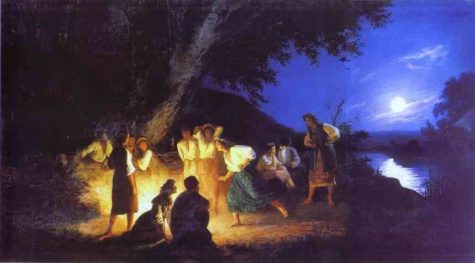
And Then It Was Banned
In the XVIII century, there were a number of documents testifying to the fierce struggle of the Church and secular authorities with the Kupala rite.
For example, in 1719 Hetman of Zaporizhzhia Army, Chairman of the Cossack state of the left bank of Ukraine, Ivan Skoropadskyi issued a decree “On parties, fisticuffs, gatherings on the holiday of Ivan Kupala etc.”, which granted the right to physically punish (tie up and beat with sticks) and excommunicate from the Church all participants of Kupala games.
In 1723, Przemysl Cathedral in Bereziv banned dancing and entertainment near the Kupala fire. In 1769, Catherine II issued a decree banning the holiday. And despite all the prohibitions, the pagan nature of folk rituals was strong. The church did not ban the holiday, but it did try to fill it with Christian content.
It is the pagan essence, mysticism, marriage-erotic motifs of Kupala rite that attracted the attention of many researchers and artists. Thanks to public ritual such art masterpieces as the Opera “Ivana Kupala” by S. Pysarevskyi; folklore work of L. Ukrainka “Kupala in Volyn”; the story of M. Gogol “Night of Ivan Kupala”; the film of Yurii Ilienko “Night on Ivan Kupala”; the Folk Opera of Y. Sankovych “When the fern blooms.” The latter during 40 years was banned and only in 2017 its world premiere took place on the stage of the Lviv Opera.
Kupala Today
At the beginning of the twentieth century Kupala rite gradually began to disappear. Today it exists in the “revived”, or rather “introduced” in Soviet times (during the anti-religious struggle) form of staged ceremony.
Although the magical meaning of rituals was leveled, and the celebration gained artistic value, the main pagan ritual actions have reached us – weaving of wreaths by girls and letting them into the water; honoring Kupala tree with dances; kindling the fire and jumping over the fire; ritual bathing; burning or sinking of trees; the burning of sacks of straw or stuffed dolls; the ceremonial dinner.
It is interesting that the name of the holiday, and the ritual fire, and decorated tree are called “Kupalo”, “Kupailo” or “Kupailytsia”. These are also the main elements of the rituals, which are based on the cult of fire, water and vegetation. Rituals symbolize the union of male (fire) and feminine (water) elements, were carried out with the aim of ensuring productivity, health, procreation.
On the territory of Ukraine for many centuries Kupala customs changed and they were not everywhere equally preserved. The majority were saved in Polissia as one of the more archaic zones of the Slavic world.
The holiday is still enthusiastically celebrated by the younger people of Eastern Europe. The night preceding the holiday (Tvorila night) is considered the night for “good humor” mischiefs (which sometimes would raise the concern of law enforcement agencies).
On Ivan Kupala day itself, children engage in water fights and perform pranks, mostly involving pouring water over people. Many of the rites related to this holiday are connected with the role of water in fertility and ritual purification.
According to ancient traditions, Ivan Kupala is the festival of the sun, and the most important role in mystical rites belongs to the power of fire. Our ancestors believed that the fire is the sun-embryo in the womb. Therefore, in the Kupala night taken to jump over the fire.
On Kupala day, young people jump over the flames of bonfires in a ritual test of bravery and faith. First, the oldest of the young men jumped over the fire.
For the highest jumpers it predicted a good harvest and prosperity for his family. Then pairs would jump, traditionally it would be a boy and a girl, but I assume that in some areas it’s permissible for pairs of any kind to take the jump together. If the couple is successful in their jump over the fire – they will certainly marry. The failure of a couple in love to complete the jump, while holding hands, is a sign of their destined separation. And anyone entering the flames during their jump can expect trouble
On the evening of July 6, unmarried girls take wreaths they have woven and throw them into the water. Unmarried men then try to grab the one belonging to the girl they are interested in. If you snag a wreath, the girl who made it will be expected to kiss you and the two of you will be paired up for the evening.
Girls may also float wreaths of flowers (often lit with candles) on rivers, in an attempt to gain foresight into their romantic relationships based from the flow patterns of the flowers on the river.
When the fun subsides, many people light candles from the hearth on pre-prepared wreath baskets and go to the river to put them on the water and thus honor their ancestors.
There is an ancient Kupala belief that the eve of Ivan Kupala is the only time of the year when ferns bloom. Prosperity, luck, discernment, and power befall whom ever finds a fern flower. Therefore, on that night, village folk roam through the forests in search of magical herbs, and especially, the elusive fern flower.
Traditionally, unmarried women, signified by the garlands in their hair, are the first to enter the forest. They are followed by young men. Therefore, the quest to find herbs and the fern flower may lead to the blooming of relationships between pairs within the forest.
It is to be noted, however, that ferns are not angiosperms (flowering plants), and instead reproduce by spores; they cannot flower.
In Gogol’s story The Eve of Ivan Kupala a young man finds the fantastical fern-flower, but is cursed by it. Gogol’s tale may have been the stimulus for Modest Mussorgsky to compose his tone poem Night on Bald Mountain, adapted by Yuri Ilyenko into a film of the same name.
Sources:
There is a lot to celebrate in July. This is a list of pretty much everything that goes on during the seventh month of the year. Many of these dates change from year to year. The days that change are marked with this » symbol.
July Lore and General Info

Astronomical Events
- July 3 thru August 11: Dog Days of Summer
- July 10 » New Moon
- July 12 thru August 23: Delta Aquarids Meteor Shower
- July 17 thru August 24: Perseids Meteor Shower
- July 24 » Full Moon – Buck Moon
Astrological Events
Depending on which astrological system you adhere to, these are the signs that show up in July of 2021. Be aware that some of these dates will vary from year to year. Unlike the Sun signs which might just shift by 1 or 2 days, the dates of the various Moon signs will vary widely from year to year. The same holds true for the Chinese Zodiac. The Celtic Tree Signs are based on an arbitrary system and stay the same from year to year.
Western Astrology
The July Sun begins in Cancer and finishes up in Leo:
- Jun 21 thru Jul 22 » Sun in Cancer
- Jul 22 thru Aug 22 » Sun in Leo
The moon cycles through the signs as follows:
- Jun 1 – Jul 3 » Moon in Aries
- Jul 3 – Jul 6 » Moon in Taurus
- Jul 6 – Jul 8 » Moon in Gemini
- Jul 8 – Jul 11 » Moon in Cancer
- Jul 11 – Jul 13 » Moon in Leo
- Jul 13 – Jul 15 » Moon in Virgo
- Jul 15 – Jul 17 » Moon in Libra
- Jul 17 – Jul 19 » Moon in Scorpio
- Jul 19 – Jul 21 » Moon in Sagittarius
- Jul 21 – Jul 24 » Moon in Capricorn
- Jul 24 – Jul 26 » Moon in Aquarius
- Jul 26 – Jul 28 » Moon in Pisces
- Jul 28 – Jul 30 » Moon in Aries
- Jul 30 – Aug 2 » Moon in Taurus
You will notice that the Moon might begin the day in one sign and by the end of the day may have moved into another sign, so timing matters if you are wanting to be precise.
The Celtic Tree Signs in July:
- Oak: Jun 10 – Jul 7
- Holly: Jul 8 – Aug 4
The Alternative Celtic Zodiac is as follows:
- Apple: Jun 22 – Jul 2
- Fir: Jul 3 – Jul 13
- Elm: Jul 14 – Jul 24
- Cypress: Jul 25 – Aug 4
The Chinese Calendar and Zodiac
We are currently in the year of the Ox (sometimes referred to as the Cow). Each Month is also assigned a specific animal. Here’s what shows up in July 2021.
- Horse: Jun 5 – Jul 6 (Chinese Zodiac – Stem Branch Calendar)
- Horse: Jun 10 – Jul 9 (Lunar Calendar – 5th Lunar Month)
- Sheep: Jul 7 – Aug 6 (Chinese Zodiac – Stem Branch Calendar)
- Sheep: Jul 10 – Aug 7 (Lunar Calendar – 6th Month)
Note: The traditional Chinese Astrology birth chart is built by the Chinese Stem Branch Calendar, not the Chinese Lunar Calendar, which I think is really confusing. Because of a difference in time zones, the lunar months will have different pattern between China and the USA.
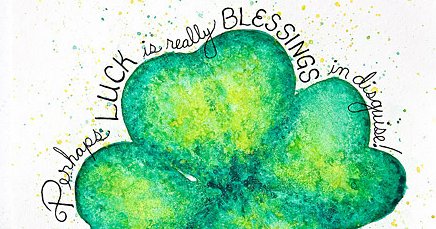
Lucky and Unlucky Days
You might want to plan moving, traveling, major purchases, court dates, and weddings around these dates, avoiding the unlucky days and utilizing the lucky ones.
- These are the lucky days in July:
9, 15 and 28. - These are the unlucky days in July:
3, 10, 17, 18 and 21.
Fatal Days
The thirteenth is a fatal day,
The tenth alike will mortals slay.
Holidays and Holy Days
Many of the holidays begin on the eve of the night before and end on the eve of the day of. It’s also important to remember that the dates of archaic festivals and feast days may vary widely depending on the source.
July 1
- 1: Canada Day
July 2
- 2: Feast of Expectant Mothers
- 2: World UFO Day (sometimes celebrated on June 24)
July 3
July 4
- 4: Independence Day
- 4 » Dakini Day (Tibetan)
July 5
- 5: Poplifugia
- 5 » Day of Ekadashi (Hindu)
- 5 thru 21: Naadam Festival
July 7
- 7: Festival of the Handmaidens – Nonae Caprotinae (“the nones of the wild fig”)
- 7: Festival for the Pales (also on Apr 21)
- 7: Tanabata – The Star Festival (Japan)
- 7: Rumilia Festival – see also Poplifugia
July 9
July 10
- 10: Day of Hel
- 10: Festival of Knut the Reaper
- 10: Lady Godiva Day
July 11
- 11 » The Noumenia
July 12
July 13
- 13 thru 15: OBon Festival – see also Aug 13 – 15
July 14
- 14: Bastille Day
July 15
- 15: Day of Rauni
July 16
- 16: World Snake Day
July 18
- 18: Day of Bad Omens – Black Day (Also Oct 6)
July 19
- 19 » Umi no Hi – Marine Day
- 19: Lucaria
- 19 and 20 » Eid al-Adha
July 20
- 20 » Day of Ekadashi (Hindu)
July 23
- 23: Neptunalia – the festival of Neptune, the Roman god of the sea.
- 23 thru Aug 1 » Boryeong Mud Festival
July 24
- 24 » Asalha Puja Day
- 24: Pioneer Day
July 25
- 25: Plant A Turnip Seed Today
- 25: A Day Out of Time
- 25: Furinalia
- 25: Day of Aegir and Ran
July 27
- 27 thru 31: The Five Epagomenal Days
- 27: Birthday of Osiris
July 28
- 28: Birthday of Horus
July 29
- 29: Birthday of Set
- 29: Honoring The Thunder God
- 29: Stikklestad Day – Honors the Asatru martyrs who died rather then submit to gray slavery.
July 30
- 30: Birthday of Isis
July 31
- 31: Birthday of Nephthys

Saint Days
There is a surprising amount of magick associated with Saint days. This is a very short list of the Saint days in July, there are many many more. As time goes by I may end up listing them all, but for now, this is what I have.
- 11: St Benedict Day
- 15: St. Swithin’s Day
- 15: St. Vladimir the Great Day
- 16: Feast of Our Lady of Carmel
- 22: Feast of Mary Magdalene
- 23: Saint Anne’s Eve
- 25: St. James the Great Day
- 26: Feast of St Anne

Recipes For July
Many more seasonal recipes, including recipes for new and full moon ceremonies, ancient Greek and Roman holy days, Asian festivals and etc can be found here: Seasonal Recipes.
![]()
Notes:
Any July lore, almanac, astrological, and celebration dates that have been shared after this post was published can be found by searching the July posts to see what’s new.
A lot of work went into this post which was compiled from various sources by Shirley Twofeathers for The Pagan Calendar. You may repost and share without karmic repercussions, but only if you give me credit and a link back to this website. Blessed be.
Nagoshi no Harae, literally “summer passing purification ceremony” is one of Japan’s most celebrated great rituals and is steeped in tradition. The purification ritual has been performed at shrines since ancient times, in the hope of atoning for misdeeds that have been committed in the first half of the year and to pray for the latter half yet to come. It is a chance for redemption and a new start for the remainder of the year.
Traditionally performed on the last day of the sixth month, the custom is still enjoyed today in modern Japan, every June 30, at many shrines across the country. Because the Nagoshi-no-Oharai falls between rice sowing and harvest, this ritual is a time of relaxation and community celebration.
In order to participate you can join in on June 30th when the priests of Shinto shrines all across Japan lead large crowds in the practice, or you can try it by yourself.
Create a ring of Miscanthus reeds, (also called Chinese Reed, Ramie, or Elephant Grass). Simply bow, pass through the wreath and circle back to the front from the left, pass through again to the right, then pass through one last time. Just remember left, right, left like the sign for infinity ∞. As you pass through the ring, reflect on your year.
The key to all rituals performed in Shinto is the harmony between heaven and earth. The rituals create the space and process whereby you can return to the fullness of the inborn Kami — the divine in each person.
In Shinto, the Kami is the object of reverence. A word that cannot be translated
adequately into English, its most common translation is “God.” However, Stuart D. B. Picken writes in his “Historical Dictionary of Shinto” that “Divinity, the divine, or the mysterious are better candidates because they are less specific in the imagery they generate.”
Where to participate in Kyoto
Several of Kyoto’s most famous and popular shrines host the event including:
- Kitano Tenmangu Shrine, home to the largest chinowa in Kyoto (approximately five meters in height), which is set up at the shrine gate.
- Kamigamo Shrine also performs the ritual as well as handing out paper dolls to the participants, which are floated down the river to rid you of misfortune.
- Yoshida Shrine is another popular host of the event, where participants who offer a doll amulet to the deity are gifted a wreath in return.
The Ritual at the Tsubaki Grand Shrine
Tsubaki Grand Shrine was established over 2,000 years ago and has been the site of the same daily Shinto purification rituals ever since, including the Nagoshi-no-Oharai.
During the Nagoshi-no-Oharai, the Torii pathway leading to the Tsubaki Grand Shrine is transformed with hundreds of people attending this ritual. The Torii gateways are a distinctive symbol of Shinto and represent a gateway between heaven and earth. Although stylized over the centuries, the original gateway was most likely a simple rope hung between the trees or posts to mark an area considered sacred.
At the Tsubaki Grand Shrine, there are a succession of Torii leading up to the Honden, (the main worship hall), where the rituals are conducted. This Honden holds about 75 people and is built in the classical style of plain, unpainted Japanese cypress, with a stylized roof distinguished by ridge posts.
Along the sides of the gravel Torii pathway hang ropes tied with white paper streamers, called gohei, signifying the boundary of sacred space. The gohei are made in different sizes by the Shinto priests and are also considered sacred.
A large sacred ring, called chi-no-wa, made of loosely twisted Miscanthus reeds, is constructed in front of the Honden. There are numerous purification rituals as people wait for the start of the Nagoshi-no-Oharai.
The Nagoshi-no-Oharai ritual begins in the main worship hall with the traditional Oharai prayers and purification.
During the purification ritual, the Shinto priests cascade kirinusa (small cut pieces of sacred rope and cloth) onto all the worshippers in the Honden. Some priests then run out of the Honden and through the crowd lining the pathway, tossing kirinusa on them.
When they complete their daily Oharahi-no-Kotba, the worshippers line the Torii pathway in anticipation of the afternoon ritual service. Following the Ohara-no-Kotobai, the chief priest (Guji) leads all the other priests, who carry crates of paper dolls, three times through the chi-no-wa in a figure eight pattern.
Worshippers follow behind a reed boat (kaya-fune) carried by a senior priest. They know their routine in the ritual, a yearly tradition that passes from generation to generation, and wait patiently in silence for their opportunity to walk through the circle of reeds. This gentle, respectful procession reflects the learned knowledge of all participants.
Passing though the chi-no-wa, although complex, is executed smoothly and is amazing to watch. The paper dolls in the crates come from all those who have visited the Tsubaki Grand Shrine in the previous six months with special prayers, impurities, pollution, uncleanness, concerns or indulgences called tsumi. Each paper doll includes the name of the person, his or her birthday and a personal stamp.
(The Japanese use stamps in their daily lives to identify paperwork and bills. When you receive or pay for something, you get the stamp of the person who processed it, confirming that you have seen the document.)
These paper dolls are symbolic of a person’s tsumi and have been purified at the Tusbaki Grand Shrine before they’re carried by the Shinto priest through the circle of reeds and then to the riverbank.
After completing the walk through the circle of reeds, the priests go to a location on the river close to the shrine. Over the days leading up to the ritual, the priests have created a sacred space along the riverbank by hanging rope with gohei across the river. Along the far shoreline, a priest also places a large pole with hanging gohei.
In all Shinto purification rituals, sake and salt are used. The Guji (chief priest) sprays these into the sacred river water while reciting prayers. The Guji also make an offering to the Kami by presenting a Japanese evergreen – sakaki –the same offering presented at all Shinto shrines.
After the river purification is completed, the priests fling the paper dolls into the air like hundreds of white petals and let them float to the sea, signifying the release of impurities.
A Shinto Prayer for Purification
The kami shall lend ear to the sacred words.
No offences shall remain unpurged.
They shall be scattered and blown afar
by Heaven’s winds
descending through the eight-fold clouds.
Morning mists shall be cleared
by the morning winds,
Just as the mists of evening shall be swept away
by evening winds.
As a large ship anchored in a harbor
casts off the morrings from its bow
and is released into the great expanse of ocean,
So shall we be released of our impurities
As the trees of the thick grove rooted yonder
are cleared away with a sharp sickle~
So shall our offences be purged and swept away.
We pray that these impurities be swept away and that
The kami grant us purification to restore
the natural order.
Let the impurities be swept away by the kami Seoritsu Hime
Who dwells in the swift rivers that cascade
from the top of the high mountains
and from the top of the low mountains,
Carrying the impurities out to the great expanse of ocean;
There, where the river meets the great sea,
Hayakitsu Hime, who dwells
within the whirling myriad tides,
Shall open wide and swallow the impurities;
Let the door open, then, from the bottom country,
And the kami called Ibukido Nushi shall cause
great winds to expel the impurities
to the root country.
There, the kami called Haya Sasura Hime,
the quiet wanderer of the root country,
will sieze and dissolve the impurities,
Ridding us of imperfection and
returning us to our pristine natural state.
Grant us purification, grant us clarity.
We pray to the Heavenly Kami
and to the Earthly Kami ~
To all the myriad of kami
we recite this norito with awe and reverence.
Please hear these humble words.
Minazuki
The seasonal sweet minazuki, a type of steamed cake topped with azuki beans, is often sold during the ritual period. It is traditionally eaten on June 30th to ward of evil, ill health and bad luck for the second part of the year. The colour of minazuki is said to resemble ice to cool you from the summer heat. Here’s a recipe from Tokyo Pony.
You will need:
- A square container around 4×4 inches
- Something to steam the wagashi in (I used a bamboo steamer)
- 15g of kuzu root ( if it is not in a powder and more in chunks crush into a powder)
- 15g of glutinous rice flour ( the kind for making dango )
- 30g of sifted plain white flour
- 30g of unrefined caster sugar
- 100ml of water
- x1 can of sweet red beans
Combine the kuzu powder and dango flour then add a little of the water to make a paste, then add the rest and mix together. Then add in your flour and sugar and mix to combine.
Fill your container with water and tip it out ( this will just stop your wagashi from sticking ) then fill your container with your mixture, keeping a few tablespoons for later.
Place your container in a steamer and steamer over simmering water for about 20 minutes.
After this time take out your container from the steamer and add around 3/4 of the can of your sweet red beans to the top, spreading them out. Add the few spoonfuls of the remaining mixture you saved over the beans and pop back in the steamer for a further 10 minutes.
Remove and allow to cool in the fridge. Cut the wagashi while it in still in the container. If you cut it in an X from corner to corner, you will have 4 triangles. Carefully ease out the first piece, once you have one out the others are easily removed. I wouldn’t recommend tipping it upside down as you may spoil the look of your minazuki.
There you have it. They are nice enjoyed with a matcha tea you could even dust the top with matcha or kinako if you like.
The History of Nagoshi no Harae
Nagoshi no Harae was first established during the Nara Period (710-794) and was traditionally performed on the last day of the sixth and twelfth months of the lunar calendar at the Imperial court and Shinto shrines. The great purification at the Imperial court briefly came to an end due to the Onin War (1467-77), but continued to flourish at shrines. At some point, the twelfth month purification (harae) was abandoned and the sixth month purification (nagoshi no harae) became grander in scale.
The origin of the ritual comes from an ancient Japanese legend about the wandering god Susano’o no Mikoto. A poor man, Somin Shorai, showed the disguised god every luxury he could afford when asked for a place to stay the night. In return for housing the god for the night, he was given a chinowa wreath woven from reeds and instructed to wear it for protection.
In a turn of good luck, Somin and his descendants managed to escape plague and illness that befell the land. This story led to the practice of passing through the large Nagoshi no Harae chinowa wreath to ward off disaster and misfortune.
Sources:
- Culture Trip
- Tsubaki Shrine
- Starr King School
- Discover Kyoto
- Shinto Norito
All humans are said to have a special Daimon or a Guardian Angel assigned to them at the time of their birth whose role is to protect and guide them throughout their life. Other Angels or Guardian Spirits may help with specific tasks along the way. By helping people, a deep friendship is forged that strengthens over time.
Hesiod wrote about divine beings that kept watch on mankind. In Works and Days, he says,
“After the earth had covered this generation… they are called pure spirits dwelling on the earth, and are kindly, delivering from harm, and guardians of mortal men; for they roam everywhere over the earth, clothed in mist and keep watch on judgements and cruel deeds, givers of wealth; for this royal right also they received… For upon the bounteous earth Zeus has thrice ten thousand spirits, watchers of mortal men, and these keep watch on judgements and deeds of wrong as they roam, clothed in mist, all over the earth.”
A person should always thank their Guardian Spirit for their help. Some people can feel their presence through sight, touch, smell or sound. Some may even have dreams and visions about them. These are subtle means of communication and should not be overlooked.
There are several ways to develop a dialog or a relationship with your Guardian Angel:
- Write your angel a letter.
- Angels enjoy all mediums of art, so try singing to them or painting them a picture.
- Say a prayer to your angel.
- Simply start talking to your guardian angel.
- Create a small altar or dedicated sacred space in honor of your Daemon.
Today is an excellent day to begin a more conscious relationship with the Guardian Spirit that has been with you from the day you were born. Light a candle and spend some time in quietude, so that you can thank your Guardian Spirit and listen for its voice.
Remember, your Guardian Angel is not your “property” or your “pet. ” They might not always do what you ask them to do. Also be aware that Guardian Angels are beings of light and will never harm nor be unkind to you. They will always steer you in a direction that is in your best interests, and you will always have the choice to ignore their gentle nudges.
Sources:
Oak month falls during a time when the trees are beginning to reach their full blooming stages. The mighty Oak is strong, powerful, and typically towering over all of its neighbors. The Oak King rules over the summer months, and this tree was sacred to the Druids.
The longest day of the year and the shortest night fall during the Oak Month. Known as the Summer Solstice, celebrations revolve around the power of the Sun at its zenith. Folklore decrees that “He who sleeps on the shortest night shall sleep all year”, meaning that this is a time for action not rest.
- Dates: June 10 – July 7
- Celtic Name: Duir
- Language of Flowers: Bravery, Hospitality
- Qualities: Tree of the Gods, Strength, Power, Longevity, Endurance, Sacred, Fire, Lightning, Protection, Love, healing,
- Themes: Strength, Power, Fertility, Luck, Success.
The Oak tree has long been venerated by people of many cultures as a symbol of strength and power. The Celts called this month Duir, which some scholars believe to mean “door”, the root word of “Druid.”
The Oak is connected with spells for protection and strength, fertility, money and success, and good fortune. Carry an acorn in your pocket when you go to an interview or business meeting; it will be bring you good luck. If you catch a falling Oak leaf before it hits the ground, you’ll stay healthy the following year.
Feel energized by the power of the Sun and Oak during this energetic time of year. Harness powerful solar energies for Oak Moon work to bring cheer and success to your life. Energy at this time should concentrate on areas of life that fall under sunny auspices such as health, success, prosperity, and blessings. Cast energy that injects solar flare into your projects by decorating you home with gold and yellow. Wear orange to boost your vitality and stamina.
Often linked with the fairies and ghosts, Midsummer brings the perfect opportunity to summon assistance from the spirits. Ask for help to being beneficial results from creative plans.
Oak the Stabilizer
The Celtic druids knew that, when a child was born under the Oak sign, it’d possess a special gift of strength. People from this Celtic tree astrology sign become protectors of the weak and speak for those who don’t have a voice. They are generous, helpful, and gentle. The Oaks have a deep understanding of history and ancestry and maybe that’s the reason why many of them become teachers.
Oak is a manly tree, and the people born under its rule are “people of action”. These people were given the ability to be the protectors of the weak and oppressed. They are literally the embodiment of spiritual power, great courage and determination.
Oak people are usually well-built and physically strong. They are straightforward and honest. They always try to find the easiest way to achieve their goal; they never shy away from dealing with problems and never use intrigues or do something that is not right.
Suitable partners for this crusader of the Celtic tree zodiac are Ash and Reed, but can reach harmony with Ivy signs too.
Oak Magick and Lore
The Oak is a sign of strength, both the strength of its branches and wood, and its strengthening qualities as a medicine and magical tree. All cultures have revered the Oak and sought such strengthening qualities, and that strength can be seen throughout the lore.
Tied to the ancient term for “druid” as “Oak knowledge” Oak has long been associated with knowledge and wisdom. We can see this also in the Native American lore, where Oak “makes space for councils”.
The Oak can be used as a haven for restoration. When your spirit needs rest and comfort it can be soothed beneath the tree’s vast branches and many sacred rituals were conducted in the shadow of an Oak tree in Ancient Britain. Meditating with your spine resting on the trunk of an Oak tree soothes the nervous system and induces feelings of inner peace.
Oak trees conduct the energy of endurance and strength, offering a magical remedy for fear and despair. They bring courage and protection from adversity.
The great size and age of the Oak made it a symbol of the continuity of the community. The water that collects in the dips in its branches was though to be sacred and used to cleanse and heal the body of negative energy.
Each Oak tree was believed to be the home to a multitude of faeries and each acorn was thought to be the home to a sprite. Bringing an acorn into the house was one way to develop a stronger relationship to the faerie world.
Oak has low electrical resistance and is often struck by lightning. So forests of Oak attracted violent electrical storms – and as lightning was seen as a message from the gods, so Oak came to be associated with the gods of storm, thunder, and lightning.
Thunder was said to be the voice of Zeus – and an Oak tree that had been struck by lightning was believed to be particularly sacred.
A purification ritual for the Oak Moon
You can burn Oak leaves to purify the atmosphere and banish fear and doubt. You will need:
- Small bottle of wine
- Basket
- Pestle and mortar
- Needle and thread
- Fireproof bowl
- Charcoal disc and matches
On the night after the full moon go to an Oak tree and pour a libation of wine onto the roots, asking the tree for its help. Gather a basket of leaves and sew them together, then hang up the leaves to dry out for three days.
When the leaves have dried, carefully remove the thread and pound the leaves with a pestle and mortar into incense. Light the charcoal in the fireproof dish. When it glows red add the dried leaves to create an energetic purification smoke.
Sources:
June 9 is St Columba’s day which is said to be the luckiest day of the year, so a good day to start any project you wish to flourish. St. Columba’s feast no longer appears on the General Roman Calendar, but is a Feast Day in Ireland’s National Calendar.
Saint Columba’s Feast Day has also been designated as International Celtic Art Day. The Book of Kells and the Book of Durrow, great medieval masterpieces of Celtic art, are associated with Columba.
St Columba is the patron saint of bookbinders and poets, and was said to have performed over a hundred miracles in his life – you don’t get saints like that any more! He did everything from expelling demons, calming storms and wild animals, and restoring a child to life, to more mundane miracles such as miraculously sending a staff to a colleague who had managed to leave it behind when he went on a voyage, and my favorite: exorcising a demon from a bucket and restoring the spilt milk to it.
There is even a story that has been interpreted as the first reference to the Loch Ness Monster. According to Adomnán, Columba came across a group of Picts burying a man who had been killed by the monster. Columba saves a swimmer from the monster with the sign of the Cross and the imprecation, “Thou shalt go no further, nor touch the man; go back with all speed.”
The beast flees, terrified, to the amazement of the assembled Picts who glorified Columba’s God. Whether or not this incident is true, Adomnán’s text specifically states that the monster was swimming in the River Ness – the river flowing from the loch – rather than in Loch Ness itself.
In another story, a poor farmer had only five cows; Columba blessed them, saying that the farmer would one day have 105 cows. Adomnán recorded that this came true, but didn’t say how long it took. He did say, though, that the man never had any more than 105 cattle: whenever the cattle reached that number, something would happen to the extra.
Columba would not, though, allow any cows on the island of Iona. He said that women always follow cows to tend them, and thus, cows bring trouble. One time, five men were fishing in the river Sale and caught only five fish. Columba said “God will provide a bigger fish for me; try your nets again,” and they caught the biggest salmon they had ever seen.
St. Columban, abbot, is the patron of shepherds, and one of the patron saints of Scotland. There is a tradition of rye or oat cakes baked in his memory.
A St Columba Day Story
There is a story which is told at this time of the year about the little children of northern Scotland, and our children of southern Ohio love to hear it. How easily we are united in brotherhood by common interest!
As June 8, the eve of St. Columba’s Day, arrives, our green hills are flicked with puffs of white wool. The older sheep have been sheared, but the fat little ones are as broad as they are long. The newborn ewe lambs have learned to skip and dance, while the young rams pretend to be very fierce as they bump their curly heads in play.
Just so the hills of the Hebrides must have looked when St. Columba and his twelve companions arrived in Scotland away back in the sixth century. The people were called Picts at that time and their lives depended upon sheep raising.
It was an easy step for them to understand the message of the Good Shepherd. St. Columba, in imitation of his Master, gathered Scotland’s souls to himself, gave them a sheepfold of faith in the island Monastery of Iona. As a “faithful and wise servant, whom his Lord setteth over his family, he gaveth them their measure of wheat in due season.”
It is true that he died at the foot of the altar while he was blessing “his sheep” in about the year 600, but some of his people remember him still.
Oak Cakes for St Columba Day
A rye or oat cake is baked in the Hebrides in honor of St. Columba. A small silver coin is placed in the dough, and the cake is toasted before a fire of rowan, yew or oak branches. The children of the house dance in impatience until the cake is finished because it is theirs and theirs alone.
Excitement rises to a fever pitch when the cake is divided, for the child who receives the silver coin has always gotten the crop of new lambs for the season. Families did know how to delegate authority before the days of 4-H groups. You see, young shepherds are trained on actual hills and on actual responsibility.
Here’s a recipe:
This oat flour cake is the perfect gluten and dairy-free treat. It is made with wholesome oats and sweetened with honey. It only requires one bowl so grab the ingredients and let’s start making this cake!
Oat flour is so easy to make, it is just ground oats! You can buy pre-made oat flour but it’s so much cheaper to make it yourself. Simply add quick cook or rolled oats to your blender or food processor; and blend until flour forms, approximately 30 seconds – 1 minute.
Measure your oat flour amount AFTER you have ground it into flour, this makes for a more accurate ratio in recipes. Also, make sure the oat flour is ground finely like traditional flour, otherwise, the cake will have a weird texture.
Use a metal or aluminum pan for this recipe, using a glass pan will result in uneven baking. The inside of the cake will be underdone and the outside will be very dark and possibly overcooked.
Ingredients
- 2 cups oat flour
- 1 teaspoon baking powder
- ½ teaspoon baking soda
- ½ teaspoon cinnamon
- ½ teaspoon salt
- ¾ cup honey
- ¼ cup olive oil
- 1 teaspoon vanilla extract
- 2 eggs
Honey Coconut Frosting
- ½ cup coconut cream, from a can
- 2 tablespoons honey
Begin making the oat flour cake by preheating the oven to 350 degrees F. Grease an 8×8 inch aluminum baking dish with cooking spray or line with parchment paper.
Next, add all of the ingredients to a large bowl and mix until well combined and smooth.
Pour the batter into the baking dish. Bake for 25-30 minutes, or until a toothpick comes out clean.
While the cake bakes, make the frosting. Scoop cream off the top of the can of coconut cream and add to a small bowl with 2 tablespoons of honey. Mix with a whisk or hand mixer until smooth.
Remove the cake from the oven and allow it to cool on a wire rack for about 15 minutes. Then remove the cake from the pan, frost, if desired and cut into equal-sized pieces. Enjoy!
Sources:
